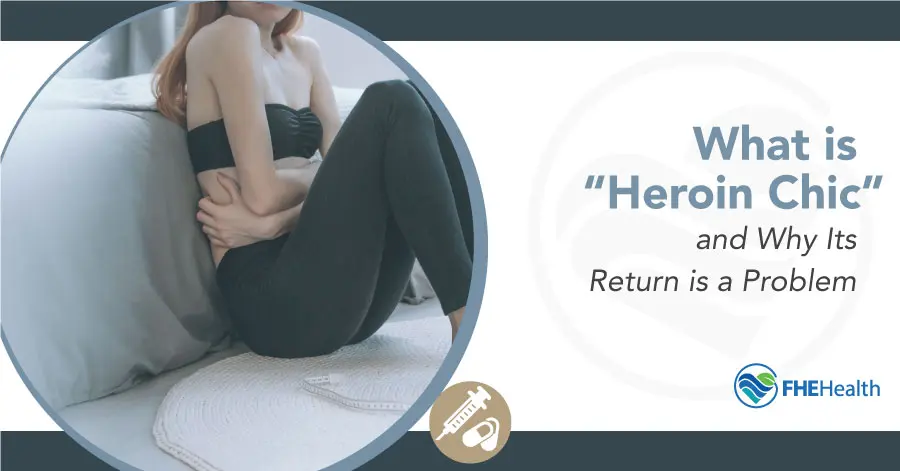
The term “heroin chic” rose to prominence in the 1980s, both as a metaphorical and literal reference to the popularity of heroin in the modeling industry. Characterized by pale skin, a very thin frame, dark undereye circles, androgynous clothing, and limp or stringy hair, heroin chic was the favored style for many designers through the early 1990s.
Originally, the term wasn’t meant as a positive statement. However, the counterculture was quick to reclaim the notion, embracing the idea to the point that it entered the mainstream world of music, fashion, and even entertainment. In one memorable episode of the sitcom Seinfeld, “The Voice,” Jerry questions Elaine about her hair, which appears flatter and less voluminous than usual. Elaine responds with a sarcastic, “It’s the new look. You know, heroin chic?” Though seemingly innocent, this off-the-cuff comment in a TV show highlights the ubiquity of the trend.
The concept wouldn’t have been inherently problematic in itself had the term’s usage not coincided with a rise in heroin use and, consequently, overdose and death rates. It didn’t last forever, however; heroin chic left the mainstream in 1997, as grunge slipped into history and the dangers of heroin were once again highlighted. However, the term may be making a comeback. That, in turn, could have the unfortunate effect of minimizing the risks of the drug.
The Origins of Heroin Chic
By the late 1980s and into the 1990s, the modeling world was dominated by fuller-figured, vivacious, and healthy figures like Cindy Crawford and Elle Macpherson. However, this didn’t resonate with the perceived style of some designers and models. The heroin chic aesthetic—one inspired by the thin, pale, anxious look of someone who is a regular heroin user—was in direct opposition to the style of the time.
Supermodel Gia Carangi is recognized as being the inspiration behind this now iconic look. In her youth, she was an outspoken fan of David Bowie and took inspiration from his eclectic looks and approach to gender play. This partially inspired her androgynous style.
After making a splash in the modeling world in New York City in 1979 and 1980, Carangi became known for her lean figure, strung-out appearance, and love of partying, including using drugs like cocaine as a part of the club scene. In time, this led to heroin use, which negatively affected her career. Her drug use reached a point where track marks on her arms were visible in photo shoots, even after airbrushing. Despite trying for many years to get clean, Carangi struggled with addiction until her death in 1986.
Carangi died at the age of only 26 from HIV/AIDS-related complications. (She contracted HIV from shooting heroin with dirty needles.) Still, even after her death, Carangi’s look was favored by many designers, with heroin chic models like Kate Moss perpetuating the trend, most notably in a 1993 Calvin Klein campaign.
Is Heroin Required?
The heroin chic look was named due to the appearance of models using heroin. Many heroin chic models were pale from lack of sunlight, were thin from undereating, had dark eye circles from partying rather than sleeping, and appeared unkempt in what is now associated with a grunge style. Heroin doesn’t directly cause these effects, but in the early days of heroin chic, drug use was the primary driver. Not all models who embodied this aesthetic used heroin, but an appearance influenced by heroin use set the stage for the style.
The Impact of Heroin Chic Culture
During the rise of heroin chic culture, the AIDS epidemic was nearing its peak, and the impact of using needles was known to be dangerous on many levels. However, this didn’t lead to a decrease in heroin use but rather to a different intake method. Snorting replaced shooting for many users, an alternative the middle class and the wealthy found far more appealing. This, coupled with the idea of heroin chic as trendy, influenced the rise of use among a larger subset of the population—and increased overdose deaths.
Heroin Chic and the Grunge Scene
Heroin chic played a large role in the grunge scene, which also encouraged its continued prominence in the counterculture. Heroin use was referenced in songs by bands like Alice in Chains, and use was prevalent among musicians in this scene as well, including Kurt Cobain of Nirvana and Andrew Wood of Mother Love Bone, who died of an overdose in 1990, Jonathan Melvoin from The Smashing Pumpkins, who died of an overdose in 1996, and Mike Starr of Alice in Chains.
Heroin Use in Movies and Pop Culture
Heroin use made its way into movies, too, like Pulp Fiction and Trainspotting. While these weren’t always desirable depictions, these kinds of movies brought heroin into the public eye.
The Decline of Heroin Chic
As the number of celebrity deaths due to heroin or related complications rose, heroin chic as an aesthetic began to fade into the background. A contributing factor to the decline was the death of Davide Sorrenti, a popular Italian fashion photographer from a longstanding family in the photography world. Much of his work glamorized addiction, including photos of models who used heroin or emulated the look. He died at the age of twenty-one in 1997. Following his death, his mother, photographer Francesca Sorrenti, spearheaded an anti-drug campaign urging magazines and advertisers to take responsibility for their role in overdose deaths and urged them to stop showcasing young teens and drug users.
In response to Sorrenti’s statements on the state of the industry, President Clinton spoke out about the dangers of glorifying addiction. By the end of 1997, the fashion business successfully pivoted away from heroin chic.
Why a Return of “Heroin Chic” Is Dangerous
Teens and young adults are consistently exposed to pressure surrounding substance abuse. Alcohol is prevalent throughout most aspects of Western life, and with the growing legalization of marijuana on a state level, smoking is becoming increasingly accepted. However, harder drugs, like heroin, are largely understood to be dangerous and highly addictive. As such, heroin is significantly less popular than drugs considered worthy of legalization, like pot. As of 2018, around 16 percent of those twelve and older were reported smoking marijuana, while only three percent used heroin.
However, the first wave of 90s heroin chic fashion normalized heroin despite its extreme dangers. The fear is that the return of this style could lead to a second wave, with young people seeing heroin use as cool and trendy rather than potentially fatal. This could lead to a rise in abuse, addiction, and overdose deaths, worsening the already severe opioid epidemic.
Heroin is extremely addictive. For some people, a few times is all it takes to develop a habit, creating a downward spiral that won’t be easy to escape. When drugs like heroin aren’t treated with the seriousness they deserve, use is likely to escalate, particularly among those who may not have considered drug use before.
Heroin use is never cool, regardless of what pop culture trends, like the return of the heroin chic aesthetic, might imply. For help with addiction to heroin or other substances, contact FHE Health today. With comprehensive inpatient and outpatient treatment programs, our resources can help those struggling with drug or alcohol addiction forge a brighter tomorrow.






